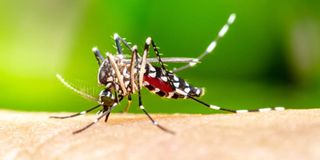Mosquito war should not stop at malaria, say scientists

Kenya’s coastal region is home to one of the most lethal mosquitoes that transmit some of the world’s most deadly viruses. PHOTO | FOTOSEARCH
The war on malaria-causing mosquito has made researchers sideline other parasites that cause deadly viruses, a study has found.
Kenya’s coast region is home to one of the most lethal mosquitoes that transmit some of the world’s most deadly viruses.
This has been found out by a group of researchers from Stanford University, who have been carrying out a study on mosquito breeding in the Coast.
According to the researchers, the coast region is emerging as a prominent host of the Aedes aegypti mosquito that transmits viruses such as yellow fever, chikungunya, dengue and Zika, some of which have no known vaccine.
Factors such as lack of clean, treated and piped water, and safe water storage containers are some of the risks that have been identified as breeding grounds for the Aedes mosquitoes.
“This breed of mosquitoes primarily breeds in water-holding containers around people’s homes. In Kwale County, for example, containers holding water with no intended purpose contained close to two thirds of all immature mosquitoes. On the other hand, containers filled with rainwater accounted for 96 per cent of all immature mosquitoes,” said Desiree LaBeaud, a professor in paediatrics at the Stanford Medical School, who led the team of scientists in the study.
“These containers are often left unattended for several days to allow for rain water to collect, which effectively creates hospitable breeding ground for this type of mosquito.”
The scientists also established that public malarial awareness has been concentrated on curbing the effects of Anopheles mosquitoes and largely ignored other mosquito breeds that also transmit diseases.
“Kenyan households prioritise sleeping under bed nets to protect themselves against malaria-spreading Anopheles mosquitoes at night. There is no awareness on day-time biting or container-breeding mosquitoes that transmit diseases such as Zika, yellow fever, dengue or chikungunya,” said Prof LaBeaud.
Yellow fever is a viral haemorrhagic disease transmitted by infected mosquitoes. Its symptoms are headache, muscle pain, nausea, fever and jaundice. The chikungunya virus is also spread by infected mosquitoes with joint pains, fever, fatigue, headache and rashes as the primary symptoms.
Dengue and Zika are also mosquito-borne diseases, with Zika being transmitted by the Aedes mosquito. Their symptoms include headache, vomiting, fever, joint pains, rashes and red eyes. Zika is particularly lethal, and can cause paralysis among patients, and birth defects among pregnant women.
Incidentally, the urban areas along the coast region were found to be more vulnerable to day-time attacks by this breed of mosquitoes than rural areas in the region. “The mosquito incidents were three times more likely to occur in urban areas than in rural areas. This means that since there is no antiviral therapy, and bed nets are not protective against the day-time biting Aedes aegypti mosquitoes, it is imperative to focus vector control efforts on reducing the number of available breeding sites,” said Prof LaBeaud in the study published in the journal PLOS Neglected Tropical Diseases 2020.


